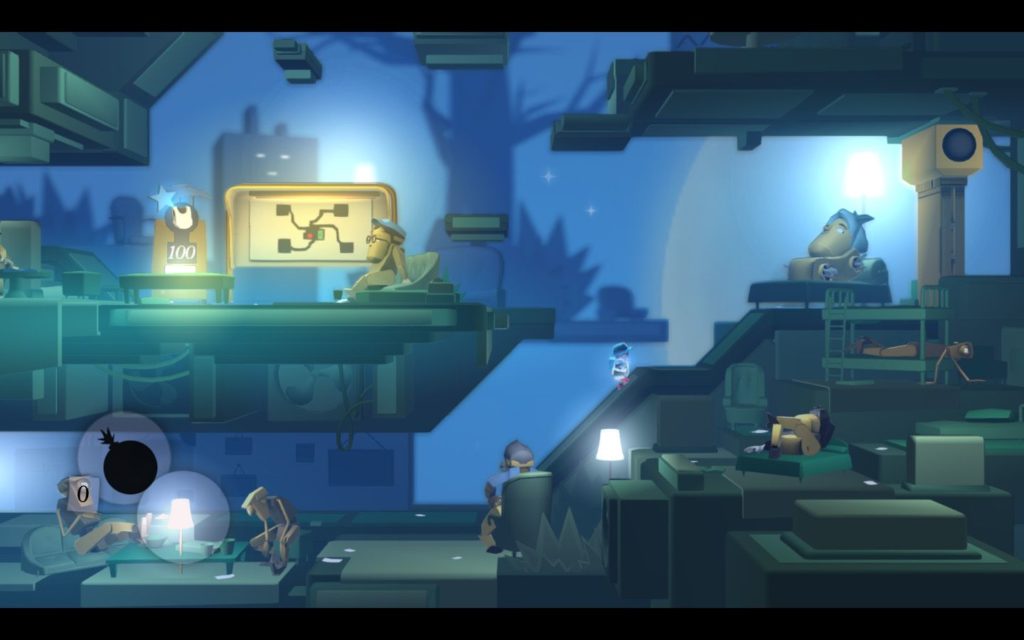Waking up on a strange planet, he stumbles to the nearest bus stop, where a couple of old men inform him there’s an indeterminate wait for the next bus… if it ever arrives at all. Nice to know that public transport is universally unreliable, eh? Anyway, rather than stay and wait, Kurt decides to take his chances by hoofing it cross country, and the adventure begins.
Pid is essentially a traditional platformer with a more modern aesthetic. It’s chock full of puzzle elements, secret areas to discover (if you can figure out how to reach them), enemies to defeat or avoid, and numerous environmental obstacles to bypass.
On his travels, Kurt will also collect various souvenirs and constellations of stars. With these you can purchase useful items, such as bombs and life vests, but these offer little assistance against bosses that are tougher than my nanna’s Sunday roast.
So far it all sounds pretty standard, but the game’s point of difference lies in a limited-duration anti-gravity beam, which you acquire early on in the game, and which can be deployed or cancelled with the push of a button. This handy tool enables Kurt to traverse gaps too wide or high to jump, and with a bit of creative thinking can also be used to force enemies into harm’s way.

Depending on the surface angle on which it is deployed, the beam will be horizontal, vertical, or diagonal, and with the ever increasing difficulty factor, there’s plenty of occasion to think outside the box. A little further in you can even have two on the go at once.
The first part of the game takes place in the grounds, innards, and rooftops of a dilapidated building, with hazards ranging from moving platforms to deadly spikes, robotic sentries, and missiles. Thanks to the uncluttered screens and fanciful, almost childlike appearance of onscreen characters, it all looks deceptively simple, but an ill-timed jump or the slightest miscalculation in trajectory can mean having to start over from the beginning of the section.
When it comes to platformers, we all love a challenge – one that will test our ability to gauge those perfectly timed, death defying leaps and show off our lightning reflexes. Unfortunately, our onscreen hero is ever so slightly sluggish with his responses, so in this particular area the game falls down somewhat… and so does Kurt – a lot. It’s a good thing he’s a ‘never say die’ kind of kid, since he will have to endure an awful lot of punishment before reaching his goal.

Co-op mode is much more fun… after all, two heads are (usually) better than one. Where a single player must struggle through each challenge alone, having a comrade along for the ride changes the dynamic quite significantly.
Suddenly you have two characters leaping about and using beams, which can be simultaneously entertaining and disastrous. Navigating a series of obstacles seems less daunting when working as a team. Plus, there’s a certain chuckle factor that comes with removing a beam you placed directly over some spikes, while the other player is hitching a ride on it… bwaahaha.
One drawback in co-op mode is that, unless you move in sync with your partner – or at least with some semblance of coordination – the risk of getting left behind and dying is quite high.
Pid uses the PC keyboard for both singleplayer and local co-op modes, and the first thing you may want to do before setting off is to reassign the keys to suit your preference. There is also an option to use a controller – a must if you want to play co-op mode, unless you reeeaaally enjoy rubbing elbows with your fellow gamer.

The controller feels more intuitive and removes that awkward keyboard fumble factor, but there’s no avoiding the fact that this is a difficult game, bristling with challenges that will test your patience. All too often, getting from one side of the screen to the other is fraught with frustration, but we have to admit it’s extremely rewarding when you manage to do so.
With the exception of a stylised cut scene, reminiscent of a school kid’s woodblock print, the game possesses an otherworldly, dreamlike quality. This is largely due to extensive use of soft focus throughout, and the result is both beautiful and eerie, with an underlying current of menace. The effect is enhanced by a smooth, chillin’ soundtrack.
So, is it worth your time and money? Well, the learning curve ain’t too steep for your average punter, but the overall difficulty is. The many, many deaths of Kurt can be demoralising and extremely frustrating; however despite this it does grow on you after a while – especially with another player to share the experience. All the same, I would recommend Pid more for serious fans of the genre, rather than the casual gamer… it’s just too damn hard.